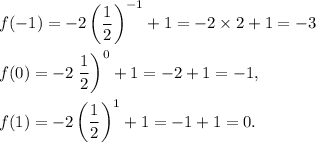Answer: The correct equation is (B)

Step-by-step explanation: We are given to select the correct equation of the function f(x) shown in the figure.
From the graph given in the figure, we have

(A) First option is

From here, we get

So, this option is not correct.
(B) First option is

From here, we get

So, this option is correct.
(C) Third option is

From here, we get

So, this option is not correct.
(D) Fourth option is

From here, we get

So, this option is not correct.
Thus, the correct function is
(B)
